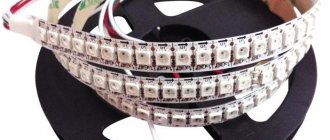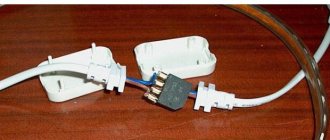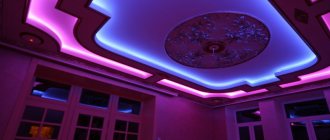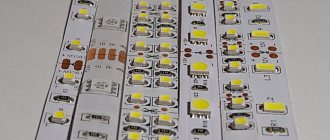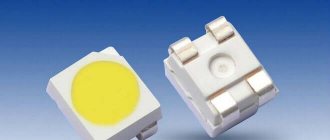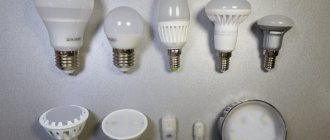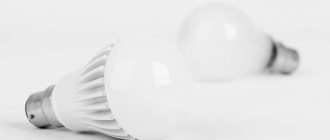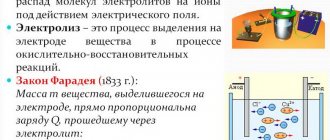Types of LEDs
SMD diodes are mounted on a flexible tape using surface mount technology (soldered to the board). DIP packages are equipped with legs, so they are mounted on a flexible board before soldering. SMD strips are flat and emit light parallel to the mounting plane. DIP is a chain of cylinders that is used for tuning vehicles, for decorating large banquet halls, facades, outdoor advertising structures, squares, even trees.
To produce monochrome (single-color) LED strips, the same type of diodes are used. They can emit red, yellow, green, blue, white light, and less often orange or pink. Products with ultraviolet and infrared radiation are available for medical institutions, greenhouses, greenhouses. White light has different shades: yellowish, neutral, blue. When installing 3 crystals in one chip, it is called RGB .
The LED strip can be ordinary and waterproof (in a silicone shell) and is marked with the letters RTW.
The degree of protection is indicated by the letters IP and numbers:
- the first is safety for people and the level of protection from external mechanical influences;
- the second is the level of protection from high humidity;
- 0 – no protection.
When installed in heated rooms, protection is not of great importance. For wet rooms, a flexible LED strip with IP67 and IP68 is selected. For outdoor installation IP43 or more.
In a standard LED strip, the number of LEDs per 1 meter is 30 or 60. With a double increase in density, the product is designated as “x2”. If the LEDs are installed in 2 rows, they are marked “2x2” (120 or 240 chips per meter).
Attention! Some manufacturers offer flexible strips with LEDs installed in 3 and 4 rows. During installation, it is necessary to take into account that due to overheating, they must be placed on a rigid metal base.
LED strips with SMD are frontal, emit light at an angle of 120 degrees. Flexible strips with DIP are end-mounted; the light flux is scattered along the installation plane, so they are used indoors for decorative lighting.
Dependence of consumption of LED strips on their type
There are lighting products on sale that are divided into several types based on power. The most commonly used tapes are 3528 and 5050. When installing a lamp, you need to take into account the number of diodes and the amount of current consumed. This will allow you to select the correct power supply and use the system safely.
LED strips 3528
This product has a simple design and low power. Tape 3528 is produced on a flexible whole strip and on a slotted base, which is protected from moisture.
Visual data will help you better understand how much energy consumption occurs in 1 m of strip, depending on the number of light bulbs in it.
| Number of diodes in 1 m | Energy consumption |
| 240 | 19.2 W |
| 120 | 9.6 W |
| 60 | 4.8 W |
LF-3528 is also sold in 30 and 90 bulbs. For home use, tapes with 60 diodes are best suited, because... they do not heat up and are easy to install.
LED strips 5050
This product is developed using new technologies and has recently appeared on the market. The tape has a bright light with fewer bulbs. The LF-5050 is considered so powerful that it is installed on billboards and buildings. There are 4 subtypes of LED strips available for sale.
| Number of light bulbs in 1 m | Energy consumption |
| 120 | 25 W |
| 72 | 15 W (1.4 A) |
| 60 | 15 W (1.2 A) |
| 30 | 7.2 W |
Builders recommend using illuminators with 30 diodes in apartments.
Voltage and current
All types of LED strips are connected to the network through a power source that stabilizes voltage and current. Standard products are designed to operate from 12 volts , but there are flexible LED strips for 5 (with built-in PWM controller), 24 and 36 volts. Good manufacturers mark the value of this parameter on the tape.
The amount of current depends entirely on what LEDs are installed and how many there are on the meter and the entire strip.
Important! When purchasing a piece (without a reel), you need to ask the seller for the voltage and current values.
Flaws
If we talk about the disadvantages, then one of them is premature failure when working in a room with elevated temperatures. LED strip SMD-5050 should not be used at temperatures exceeding 60 degrees Celsius.
If this condition is not observed, the LEDs will overheat. As a result, they may fail.
Some disadvantage of most varieties is the need for 12-volt voltage. To provide this voltage you need to buy a power supply.
If the LED strip is bent too strongly, the conductive paths will be damaged. This will happen if the bend radius is less than two centimeters. An LED strip from an unscrupulous manufacturer may have poorly soldered elements and low-quality semiconductor crystals.
Power determination
On the packaging, the power of one meter or the entire product is indicated in watts. When choosing a power supply, the main attention should be paid to this indicator.
Attention! Recently they began to produce LED strips with a voltage of 220 V, for which a converter is not required, since they are connected directly to the network.
Calculation of the power of 1 meter of LED strip
The power value of 1 m of LED strip depends on the type of LEDs that are placed on it and their number. If there is no passport or the value is not indicated (not all manufacturers have a high level of responsibility), you need to measure the meter with a tape measure, determine the length and width of the chips and count how many of them are installed.
Based on the dimensions, you can determine the type of SMD and find a table with current values (in amperes ):
- SMD 3528 – 0.02;
- SMD 5050 – 0.02;
- SMD 5630 – 0.15-0.2;
- SMD 5730 – 0.15-0.3;
- SMD 2835 – 0.06;
- SMD 3014 – 0.03;
- SMD 3020 – 0.02.
Power formula:
P = U*I*N/K, where:
U – power supply voltage;
I – current;
N – number of chips per meter;
K – number of SMDs connected in series.
All 12V LED strips have 3 chips in groups connected in parallel, so K=3 (for 24V K=6).
Example:
The size of the SMD 3020 chip is 30x20 mm, 30 elements per meter, 12 V power supply.
P = 12*0.02*30/3 = 2.4 W.
If there are 60 chips:
P – 24*0.02*60/3 = 9.6 W.
How to find out the power of an LED strip
An LED strip is a special board of a certain width to which light diodes with resistors are attached in a strictly established order. Depending on the number of components per 1 linear meter, diodes can be placed in one line, in two rows or in a checkerboard pattern.
The following table shows the power of SMD 5050 LED strips per meter of length with different numbers of crystals:
| Product type | Number of LEDs per 1 meter | Power consumption, W |
| SMD 5050 | 30 | 7,2 |
| 60 | 14 | |
| 72 | 15 | |
| 120 | 25 |
The table shows that the level of power consumption is directly dependent on the number of light diodes and the density of their arrangement on 1 linear meter of the board. Using this information, you can easily calculate how many watts are in an LED strip with 72 crystals if its length is, for example, 20 m. You just need to multiply the power consumption for this type of board by its length: 15 W * 20 m = 300 W.
Now it is important to make a competent calculation of the power of the adapter, which is the power source. Let's use a simple formula: Mb = Ml x Dl x K, in which
- MB – adapter power;
- Ml – power 1 l.m. LED strips;
- L – LED length;
- K – power reserve factor.
In our case, voltage for the LED strip should be: 15 * 20 * 1.3 = 390 W. Coefficient 1.3 provides a 30% power reserve, which is quite enough to ensure normal brightness of the LED strip over a long period of operation.
If you have chosen a board with smaller diodes labeled SMD 3528, then to calculate the power consumption of the LED strip using the above formula, use the data from this table:
| Product type | Number of LEDs per 1 meter | Power consumption, W |
| SMD 3528 | 60 | 4,8 |
| 120 | 9,6 | |
| 240 | 19,2 |
Converter calculation
When purchasing a unit for an existing LED strip, not only power is taken into account, voltage is equally important.
Attention! 12 V converters are more accessible and have a relatively low cost; if they fail, they are easier to replace.
To determine the power of the block, the power of the tape must be multiplied by 0.2 or 0.3. For the LEDs discussed above, with length of 15 m and 60 chips on each of them, its power is:
9.6*15 = 144 W.
Taking into account the coefficient:
144+144*0.3 = 187.2 W
The power supply power should be 200 W.
Attention! If you do not take into account the reserve, the unit will not be able to produce a stable voltage at the output and will overheat.
If the block seems too large, the LED strip can be divided into 2 parts, for each buy a 100- watt .
How to calculate power?
In order for the LED lamp to work for a long time and correctly, without heating up and burning out, it is necessary to calculate the power consumption. You will need to focus on this indicator when selecting a power supply. It is the connecting link between the LED strip and a 220 V outlet.
At 1 meter
To determine the power of 1 m of LED strip, you need to know the type of light bulbs and their number. After this, the energy consumption is looked at in the table and calculations are made using the formula.
Determination of power per 1 meter: P=U*I*N/K, where U is the voltage of the power supply, I is the current strength, N is the number of diodes per meter, K is the number of diodes connected together.
For example, we take a 3020 tape. In 1 m it has 30 diodes and a 12 V power supply. The power is determined by multiplying 12 by 0.02 and by 30 and dividing by 3. The result is 2.4 W per 1 m.
For the entire length of the tape
It is not difficult to calculate the power for the entire product. To do this you need to know only 2 parameters:
- tape length;
- voltage 1 m.
If these values are multiplied by each other, the required indicator will be obtained. For example, if the length of the LF-5050 LED strip with 30 bulbs is 5 m, then you need to multiply 7.2 W by 5. The entire product requires 39.6 W.
Consumption calculation
Before installing a lighting system, everyone wants to know its energy consumption .
The amount consumed by an LED strip primarily depends on the number of diodes. If we use the product discussed above, we can say that electricity consumption is the power of the power supply. To determine the exact value, you need to know how many hours daily the lighting system will be used.
If it works approximately 3 hours a day, the calculation is as follows:
200 W*3/1000 = 6 kW/day.
Types of LED strip SMD 5050
There are different types of SMD 5050 LED strips, each of which has its own set of qualities. It is noteworthy that manufacturers, when indicating the technical characteristics of lamps, indicate values per 1 m of length. For example, the most common LED strips with an LED density of 60 pcs/m of length have a power of 14.4 W/m. If the tape has 30 elements per linear meter, then the power will be 7.2 W/m. This point is important when choosing a power supply, which must have the appropriate parameters.
